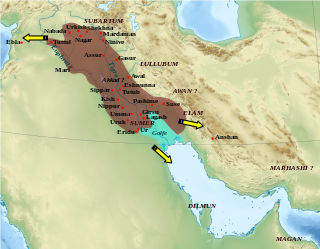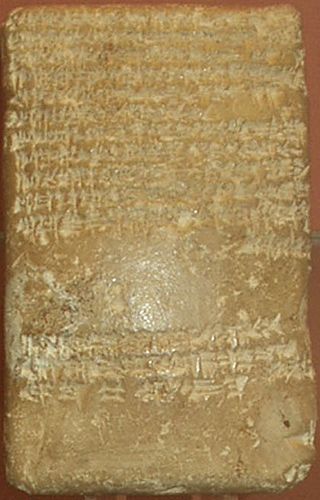Related Research Articles

The land of Subartu or Subar is mentioned in Bronze Age literature. The name also appears as Subari in the Amarna letters, and, in the form Šbr, in Ugarit.

Labaya was the ruler of Shechem and warlord in the central hill country of southern Canaan during the Amarna Period. He lived contemporaneously with Pharaoh Akhenaten. Labaya is mentioned in several of the Amarna Letters. He is the author of letters EA 252–54.

Abdi-Ḫeba was a local chieftain of Jerusalem during the Amarna period. Egyptian documents have him deny he was a mayor (ḫazānu) and assert he is a soldier (we'w), the implication being he was the son of a local chief sent to Egypt to receive military training there.
Mutbaal was a Canaanite king of the Amarna Period. He is identified in the Amarna letters as a son of Labaya, the ruler of the hill country north of Jerusalem, including the territory in the vicinity of the city of Shachmu.

Biridiya was the ruler of Megiddo, northern part of the southern Levant, in the 14th century BC. At the time Megiddo was a city-state submitting to the Egyptian Empire. He is part of the intrigues surrounding the rebel Labaya of Shechem.
DU–Teššup was the son of Aziru, of the 1350–1335 BC Amarna letters correspondence, and also the father of Aziru's successor, in Amurru. DU-Teššup's name refers to the Hurrian god of sky and storm, Teshub.

Ayyab was a ruler of Aštartu south of Damascus. According to the Amarna letters, cities/city-states and their kings in the region — just like countries to the north, such as Hatti of the Hittites, fell prey to a wave of attacks by ʿApiru raiders. The Amarna correspondence corpus covers a period from 1350–1335 BC.
Šuwardata (Shuwardata), also Šuardatu, is understood by most scholars to be the king of the Canaanite city of Gath, although some have suggested that he was the 'mayor' of Qiltu, during the 1350-1335 BC Amarna letters correspondence. Šuwardata was the author of 8 letters to the Egyptian pharaoh.
Milki-ilu of Gezer, was the mayor/ruler of the Land of Gazru (Gezer) around 1350 BC. He is known as the son-in-law of Tagi of Ginti-Kirmil and cooperating with Labaya of Shechem, during a period of turmoil among the vassals of Egypt. He is accused of being a rebel, employing mercenaries from the Habiru men.
Addaya was an Egyptian commissioner during the period of the Amarna letters correspondence. The majority of the Amarna letters were written to the pharaoh of Egypt during a 15-20 year(?) time period.

Karduniaš, also transcribed Kurduniash, Karduniash, Karaduniše,) is a Kassite term used for the kingdom centered on Babylonia and founded by the Kassite dynasty. It is used in the 1350-1335 BC Amarna letters correspondence, and is also used frequently in Middle Assyrian and Neo-Assyrian texts to refer to the kingdom of Babylon. The name Karaduniyaš is mainly used in the letters written between Kadashman-Enlil I or Burna-Buriash, Kings of Babylon, and the Pharaoh of Ancient Egypt -, letters EA 1-EA 11, a subcorpus of letters,.
Hannathon, and of the 1350-1335 BC Amarna letters, Hinnatuna, or Hinnatuni/Hinnatunu, is the Biblical city/city-state of Hannathon, ; in the Amarna letters correspondence as Hinnatuna, it is a site in southern Canaan, site uncertain. Ancient settlement of Tel Hanaton in Lower Galilee has been suggested as a candidate.

Amarna letter EA 252, titled: Sparing One's Enemies, is a square, mostly flat clay tablet letter written on both sides, and the bottom edge. Each text line was written with a horizontal line scribed below the text line, as well as a vertical left margin-line, scribe line on the obverse of the tablet. The letter contains 14 (15) lines on the obverse, continuing on the bottom tablet edge to conclude at line 31 on the reverse, leaving a small space before the final tablet edge. At least 4 lines from the obverse intrude into the text of the reverse, actually dividing the reverse into a top half and bottom half, and even creating a natural spacing segue to the reverse's text, and the story.

Amarna letter EA 364, titled Justified War, is a clay tablet letter from Ayyab, ruler of Aštartu, to Pharaoh Akhenaten.

Amarna letter EA 271, titled: "The Power of the 'Apiru," is a moderately short, tallish, rectangular clay tablet letter, approximately 3 in wide x 4 in tall, from Milkilu the mayor/ruler of Gazru (Gezer), of the mid 14th century BC Amarna letters.

Amarna letter EA 289, titled: "A Reckoning Demanded," is a moderately tall, finely-inscribed clay tablet letter, approximately 6.5 in tall, from Abdi-Heba the mayor/ruler of Jerusalem, of the mid 14th century BC Amarna letters. The scribe of his six letters to Egypt were penned by the "Jerusalem scribe"; EA 289 is a moderately long, and involved letter, mentioning ten named individuals, some more than three times. A total of nine locations are referenced, as well as men of the "Hapiru"-("LÚ-MEŠ-Hapiru-ki"), and men of "Qilyi-ki".

Amarna letter EA 286, titled: "A Throne Granted, Not Inherited," is a tall, finely-inscribed clay tablet letter, approximately 8 in tall, and 3.5 in wide, from Abdi-Heba the mayor/ruler of Jerusalem, of the mid 14th century BC Amarna letters. The scribe of his six letters to Egypt were penned by the "Jerusalem scribe"; EA 286 is a moderately long, and involved letter.

Amarna letter EA 245, titled: "Assignment of Guilt," is a medium length clay tablet Amarna letter from Biridiya the governor-'mayor' of Magidda. It is letter number four of five from Biridiya.
Amarna letter EA 254, titled: "Neither Rebel nor Delinquent (2)", is a moderate length, tall, and mostly flat rectangular clay tablet Amarna letter,. The letter is from Labaya of city-state Šakmu . It is an undamaged letter, in pristine condition, with cuneiform script on almost all surfaces: Obverse, Bottom, Reverse, and Left Side. Letter EA 254 is numbered VAT 335, from the Vorderasiatisches Museum Berlin.

Amarna letter EA 290, titled: "Three Against One", is one of the two shorter letters, of six, from Abdi-Heba the governing man of Jerusalem. In the Jerusalem letters, Jerusalem is "Uru-Salem" ("City-Peace").